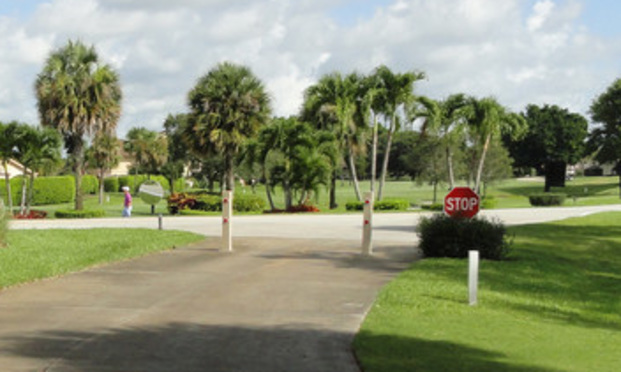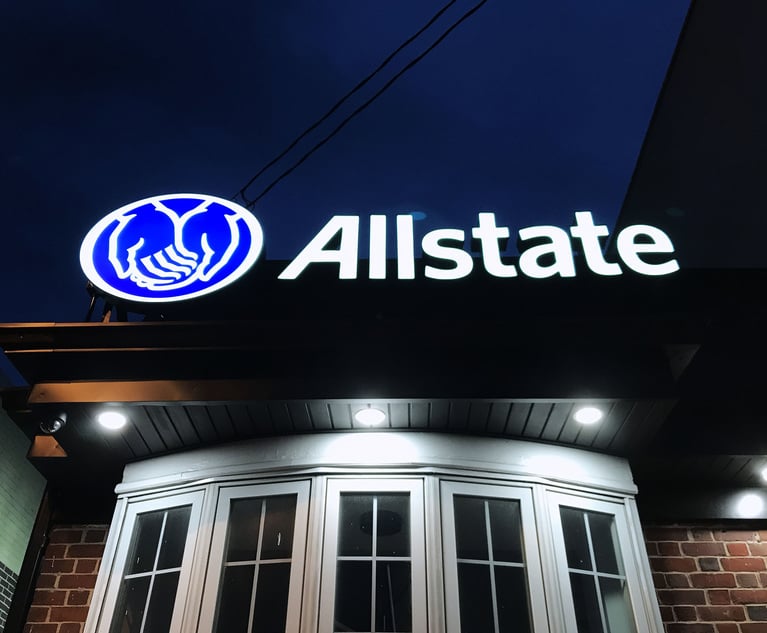Broward Lawyers Score $41 Million Verdict for Former SEC Official Paralyzed in Bike Accident
Litigators with Schlesinger Law Offices represented James Schnurr and his wife in a premises liability suit against Jonathan's Landing Golf Club, a members-only community in Jupiter.
June 03, 2019 at 03:24 PM
7 minute read
 Track in Jonathan's Landing Golf Club. Courtesy photo.
Track in Jonathan's Landing Golf Club. Courtesy photo.
Scott Schlesinger feels it's hard to call triumphant verdicts an outright win when the circumstances underpinning the case are singularly dire.
Attorneys with the Fort Lauderdale personal injury litigator's firm Schlesinger Law Offices helped to represent James Schnurr and his wife Christine in a premises liability suit against Jonathan's Landing Golf Club in Palm Beach Circuit Court.
Schnurr, the former chief accountant of the U.S. Securities and Exchange Commission, sustained a catastrophic injury while riding his bike in the member's-only community on April 10, 2016. Trailing behind his wife, Schnurr struck a stanchion which ejected him from his bike. Although his wife promptly called emergency services, the accident left Schnurr with irreparable injuries, rendering him a permanent quadriplegic and, in Schlesinger's words, committing him “to a lifetime of disability.”
“Prevailing in these kind of cases, you can't use the word 'win,' ” Schlesinger said, remarking on the debilitating nature of Schnurr's condition. “ No one can turn back the clock. … That would be a win.”
Schlesinger's brother and fellow litigator Gregg worked alongside Zane Berg and other attorneys from the Schlesinger Law Offices to net the Schnurrs a $41 million verdict against the property owners' association at the country club May 15. The plaintiffs' legal team argued the stanchion Schnurr collided with had no place on the property, was overly difficult to notice and violated decades-old safety rules for sidewalks and roadways in South Florida.
“It was an accident waiting to happen,” Schlesinger said, noting the site of the client's mishap was the only place on the property where wooden posts of that sort had been placed. “The word they used in the beautification notes on the property was camouflage. Heaven forbid there should be an unsightly yellow thing that'd be easy to see. … It has to be highly visible [for roadways], it has to be conspicuous, it has to be striped. … Everything about this was just bad.”
The case was brought to the attention of Schlesinger Law Offices by Thomas Angelo of the Angelo & Banta firm in Fort Lauderdale.
“After evaluating … I knew that Gregg and that firm were the right firm to handle the case,” Angelo said. He referred to his co-counsel as “great guys” with a great office. Angelo added he handled the real estate elements of the litigation and argued the directed verdict motion. “We worked on and tried the case together. … We're really thrilled with the success and outcome of the case.”
Berg said the plaintiff's case revolved around their contention the stanchion Schnurr hit and an identical one nearby “were illegally placed in violation of the permitting requirements” of Palm Beach County.
“A permit was definitely required for the installation of these types of objects on a multiuse pathway, even going back to the conception of this community in the late 1970s,” Berg said. “They would've been denied and rejected had they even been submitted for permitting to the applicable authorities.”
Berg said the substance of the claim revolved around the defendant's knowledge of the risks the stanchions posed to people using the promenade.
“When you get down to it, was there a dangerous condition on the property they knew or should have known about?,” he said. “Was there a dangerous condition they failed to warn our client about?”
Read the verdict form:
The case was built largely around the testimony of engineering and architectural experts who spoke to the unsafe and unlawful quality of the poles on the pathway. This included general contractor and former Boca Raton City Engineer Henry Hillman.
“He's intimately familiar with the requirements of Palm Beach County and was able to testify with authority with regards to what would have happened had plans for these bollards as installed and designed had been submitted. … These bollards would have required a permit under any of the codes, all of them,” Berg said, adding the fixtures would've been rejected by the proper officials in any iteration of the county's building regulations through the decades. “All of the witnesses that we called to testify … we thought were necessary and contributed to the case.”
The country club's answer and affirmative defenses to the plaintiff's complaint argued “James Schnurr conducted himself in a careless and negligent manner by failing to observe where he biked.” The filing contended Schnurr “was biking recklessly” and the bollards at the center of the dispute were “open and obvious at the time of the plaintiff's alleged accident.” Berg said the plaintiffs countered by directing the jury to the spatial positions of the Schnurrs when the incident occurred as well as the color of the stanchions.
“One of the flaws with their argument was they never positioned Mrs. Schnurr in front of Mr. Schnurr in any of their scenarios in front of the jury. … She was some level of obstruction to his view looking forward,” he said. Berg explained one of the reasons guidelines advise against installing stanchions on multiuse pathways is because “If the first bike rider goes around it, the second bike rider doesn't see the bollard until it's too late.”
Berg added the pole's tan and beige coloring blended in with its surroundings. “Human factors expert Robert Kennedy [testified] to the lack of conspicuity that these bollards have,” the attorney said. “One of the analogies made at trial was it was like looking for a polar bear in an ice storm.”
Schlesinger and Zane chalked up the substantial award to the extent of Schnurr's disabilities and the large earning capacity he lost as a result of the accident.
“Every single act, every single element of daily life is impaired,” Schlesinger said, adding the plaintiff was unable to travel from his New York City home to testify due to his condition.
Todd Ehrenreich, managing partner with Lewis Brisbois Bisgaard & Smith's Miami office, served on the defendant's legal team. The civil litigator said he expects “there's going to be a considerable reduction before the final verdict is entered,” pending several posttrial motions.
“Some parts of the gross verdict were not reflective of the testimony,” Ehrenreich said. “We're asking the court to further reduce to better reflect the numbers presented by the plaintiff.”
Schlesinger said regardless of what happens next, the plaintiffs and their family have already achieved “some satisfaction and a degree of relief.”
“Just getting the verdict provides some measure of a sense of justice,” Schlesinger said. “Prevailing, overcoming the opponents' defense, proving the case and having members of the community see it your way … is a form of approval and understanding, and that's a road to some sort of satisfaction of the concept of justice.”
Case: James Schnurr and Christine Schnurr v. J.L. Property Owners Association
Case no.: 2016-CA-009882
Description: Premises liability
Filing date: Aug. 30, 2016
Verdict date: May 15, 2019
Judge: Palm Beach Circuit Judge Lisa Small
Plaintiffs attorneys: Gregg Schlesinger, Zane Berg, and Cristina Sabbagh, Schlesinger Law Offices, Fort Lauderdale; Crane Johnstone, Johnstone Law, Fort Lauderdale; Thomas Angelo, Angelo & Banta, Fort Lauderdale
Defense attorneys: Todd Ehrenreich, Kathryn Ender, and Brian Goldenberg, Lewis Brisbois Bisgaard & Smith, Miami; Arthur Laplante and Martin Stern, Hinshaw & Culbertson, Fort Lauderdale
Verdict amount: $41,050,000
This content has been archived. It is available through our partners, LexisNexis® and Bloomberg Law.
To view this content, please continue to their sites.
Not a Lexis Subscriber?
Subscribe Now
Not a Bloomberg Law Subscriber?
Subscribe Now
NOT FOR REPRINT
© 2025 ALM Global, LLC, All Rights Reserved. Request academic re-use from www.copyright.com. All other uses, submit a request to [email protected]. For more information visit Asset & Logo Licensing.
You Might Like
View All

Read the Document: DOJ Releases Ex-Special Counsel's Report Explaining Trump Prosecutions
3 minute read
US Judge OKs Partial Release of Ex-Special Counsel's Final Report in Election Case
3 minute read
Special Counsel Jack Smith Prepares Final Report as Trump Opposes Its Release
4 minute readTrending Stories
Who Got The Work
J. Brugh Lower of Gibbons has entered an appearance for industrial equipment supplier Devco Corporation in a pending trademark infringement lawsuit. The suit, accusing the defendant of selling knock-off Graco products, was filed Dec. 18 in New Jersey District Court by Rivkin Radler on behalf of Graco Inc. and Graco Minnesota. The case, assigned to U.S. District Judge Zahid N. Quraishi, is 3:24-cv-11294, Graco Inc. et al v. Devco Corporation.
Who Got The Work
Rebecca Maller-Stein and Kent A. Yalowitz of Arnold & Porter Kaye Scholer have entered their appearances for Hanaco Venture Capital and its executives, Lior Prosor and David Frankel, in a pending securities lawsuit. The action, filed on Dec. 24 in New York Southern District Court by Zell, Aron & Co. on behalf of Goldeneye Advisors, accuses the defendants of negligently and fraudulently managing the plaintiff's $1 million investment. The case, assigned to U.S. District Judge Vernon S. Broderick, is 1:24-cv-09918, Goldeneye Advisors, LLC v. Hanaco Venture Capital, Ltd. et al.
Who Got The Work
Attorneys from A&O Shearman has stepped in as defense counsel for Toronto-Dominion Bank and other defendants in a pending securities class action. The suit, filed Dec. 11 in New York Southern District Court by Bleichmar Fonti & Auld, accuses the defendants of concealing the bank's 'pervasive' deficiencies in regards to its compliance with the Bank Secrecy Act and the quality of its anti-money laundering controls. The case, assigned to U.S. District Judge Arun Subramanian, is 1:24-cv-09445, Gonzalez v. The Toronto-Dominion Bank et al.
Who Got The Work
Crown Castle International, a Pennsylvania company providing shared communications infrastructure, has turned to Luke D. Wolf of Gordon Rees Scully Mansukhani to fend off a pending breach-of-contract lawsuit. The court action, filed Nov. 25 in Michigan Eastern District Court by Hooper Hathaway PC on behalf of The Town Residences LLC, accuses Crown Castle of failing to transfer approximately $30,000 in utility payments from T-Mobile in breach of a roof-top lease and assignment agreement. The case, assigned to U.S. District Judge Susan K. Declercq, is 2:24-cv-13131, The Town Residences LLC v. T-Mobile US, Inc. et al.
Who Got The Work
Wilfred P. Coronato and Daniel M. Schwartz of McCarter & English have stepped in as defense counsel to Electrolux Home Products Inc. in a pending product liability lawsuit. The court action, filed Nov. 26 in New York Eastern District Court by Poulos Lopiccolo PC and Nagel Rice LLP on behalf of David Stern, alleges that the defendant's refrigerators’ drawers and shelving repeatedly break and fall apart within months after purchase. The case, assigned to U.S. District Judge Joan M. Azrack, is 2:24-cv-08204, Stern v. Electrolux Home Products, Inc.
Featured Firms
Law Offices of Gary Martin Hays & Associates, P.C.
(470) 294-1674
Law Offices of Mark E. Salomone
(857) 444-6468
Smith & Hassler
(713) 739-1250






